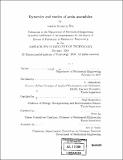| dc.contributor.advisor | L. Mahadevan and Paul Matsudaira. | en_US |
| dc.contributor.author | Shin, Jennifer Hyunjong, 1974- | en_US |
| dc.contributor.other | Massachusetts Institute of Technology. Dept. of Mechanical Engineering. | en_US |
| dc.date.accessioned | 2005-09-06T21:27:06Z | |
| dc.date.available | 2005-09-06T21:27:06Z | |
| dc.date.copyright | 2004 | en_US |
| dc.date.issued | 2004 | en_US |
| dc.identifier.uri | http://hdl.handle.net/1721.1/27043 | |
| dc.description | Thesis (Ph. D.)--Massachusetts Institute of Technology, Dept. of Mechanical Engineering, 2004. | en_US |
| dc.description | Includes bibliographical references (p. 95-101). | en_US |
| dc.description.abstract | The conversion of chemical energy into mechanical forces that powers cell movements is a ubiquitous theme across biology. The acrosome reaction of Limulus sperm is a simple example of such a dynamical transformation where a 60 [mu]m-long crystalline bundle of actin filaments, tightly cross-linked by actin bundling protein scruin, straightens from a coiled conformation and extends from the cell in five seconds. This spring-like mechanism represents a third type of actin-based motility that is distinctly different from the better known polymerization or myosin-driven processes. To identify the basis and mechanism for this movement, we examine the possible sources of chemical and mechanical energy and show that the stored elastic energy alone is sufficient to drive the reaction. We also provide an estimate of the maximum force generated during the uncoiling by stalling the bundle using an agarose gel. Finally, we provide a simple mathematical model that rationalizes the dynamics of uncoiling. Motivated by the very stiff cross-linking in the bundle induced by scruin, we next turn to a model system of scruin mediated cross-linked actin networks where the elastic response is dominated by the properties of actin. While the biological significance of the actin cross-linking proteins is well documented, little is known about how bundling and cross-linking quantitatively affects the microstructure and mechanical properties of actin networks. We quantify the effect of scruin on actin networks using imaging techniques, co-sedimentation assays. multi-particle tracking (MPT), and bulk rheology and demonstrate how a simple entropic elasticity model for a semi-flexible polymer network explains the linear elastic regime of the actin-scruin network. | en_US |
| dc.description.statementofresponsibility | by Jennifer Hyunjong Shin. | en_US |
| dc.format.extent | 101 p. | en_US |
| dc.format.extent | 5409531 bytes | |
| dc.format.extent | 5421196 bytes | |
| dc.format.mimetype | application/pdf | |
| dc.format.mimetype | application/pdf | |
| dc.language.iso | en_US | |
| dc.publisher | Massachusetts Institute of Technology | en_US |
| dc.rights | M.I.T. theses are protected by copyright. They may be viewed from this source for any purpose, but reproduction or distribution in any format is prohibited without written permission. See provided URL for inquiries about permission. | en_US |
| dc.rights.uri | http://dspace.mit.edu/handle/1721.1/7582 | |
| dc.subject | Mechanical Engineering. | en_US |
| dc.title | Dynamics and statics of actin assemblies | en_US |
| dc.type | Thesis | en_US |
| dc.description.degree | Ph.D. | en_US |
| dc.contributor.department | Massachusetts Institute of Technology. Department of Mechanical Engineering | |
| dc.identifier.oclc | 56794744 | en_US |
